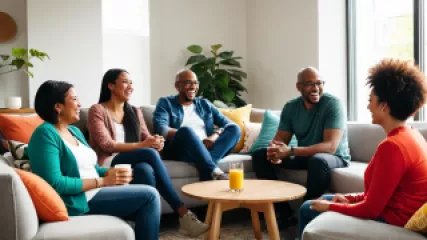How to Build a Supportive Community
How to Build a Supportive Community: A Q&A with Melanie Ford
Building a strong, supportive community can be a transformative experience, providing a sense of belonging, emotional support, and practical resources that can positively impact both individual and collective wellbeing. However, cultivating such a community is no easy feat - it requires intentionality, empathy, and a willingness to put in the work. To gain some insights on this important topic, we sat down with Melanie Ford, a community organizer and mental health advocate, to discuss the keys to creating a thriving, supportive community.
What are the primary benefits of being part of a supportive community?
Melanie: There are so many benefits to being part of a supportive community. On an individual level, it can provide a vital source of emotional support, validation, and a sense of belonging that is essential for our mental health and overall wellbeing. When we feel isolated or alone, having a community that has our back can make all the difference.
Beyond the personal benefits, communities that support one another can also drive positive change on a larger scale. By pooling resources, skills, and collective action, communities can tackle complex systemic issues, advocate for important causes, and create new opportunities that uplift everyone involved. There's a real power in numbers when a community comes together with a shared purpose.
What are some key elements that help foster a truly supportive community?
Melanie: I think the foundation of a supportive community is built on a few key elements:
- Empathy and compassion - Being able to truly listen to and understand each other's experiences, challenges, and needs is crucial. Approaching interactions with empathy and an openness to support one another goes a long way.
- Inclusivity and diversity - Embracing people from all walks of life, backgrounds, and lived experiences helps cultivate a rich, vibrant community where everyone feels welcomed and valued.
- Shared goals and values - When a community is united around common objectives, whether it's mutual support, collective action, or simply creating a safe space to connect, it provides a sense of purpose and direction.
- Collective responsibility - Everyone in the community has to be willing to contribute their time, skills, and energy towards the greater good. It can't just fall on a few individuals to keep things going.
- Authentic communication - Being able to have open, honest dialogues where people feel heard and validated is key. Avoiding judgment and creating an environment of trust is so important.
When all these elements come together, that's when you start to see a community truly thrive and support one another in meaningful ways.
What are some practical steps someone can take to build a supportive community from scratch?
Melanie: There are a few key steps I would recommend for someone looking to build a supportive community:
- Identify your community's needs and goals - Start by deeply understanding the challenges, pain points, and aspirations of the people you want to bring together. What support do they need most? What change do they want to see happen? Use this as the foundation to build your community.
- Spread the word and invite others to join - Once you have a clear vision, start reaching out to people who might be interested in getting involved. Use a variety of channels - social media, flyers, word-of-mouth, etc. - to raise awareness and extend open invitations.
- Foster regular connection and engagement - Schedule consistent events, activities, or gatherings (both in-person and virtual) that give people opportunities to come together, build relationships, and actively participate. This regular interaction is key.
- Empower community members to lead and contribute - Don't try to do everything yourself. Identify the skills, passions, and leadership potential within your community and create spaces for people to step up and take ownership. Distributed responsibility is crucial.
- Continuously gather feedback and evolve - Stay attuned to the evolving needs of your community and be willing to adjust your approach. Regularly solicit input and be responsive to the changing landscape.
Building a supportive community from the ground up takes time and dedication, but the payoff in terms of the positive impact it can have is immense. It's such rewarding and important work.
How can someone overcome challenges or resistance when trying to build a community?
Melanie: Building a supportive community isn't always easy - there can be a lot of challenges and resistance to overcome along the way. A few key things I would recommend:
- Expect and embrace the messiness - Community-building is not a linear process. There will be setbacks, disagreements, and obstacles to navigate. Approach it with flexibility, patience, and a willingness to adapt.
- Focus on building trust and relationships - Strong, trusting connections between community members are the bedrock of a supportive community. Invest time and energy into fostering those interpersonal bonds.
- Communicate transparently and authentically - Be upfront about the challenges you're facing, and create spaces for honest, vulnerable dialogue. This openness can help build understanding and collective problem-solving.
- Celebrate small wins and progress - Community-building is a marathon, not a sprint. Recognize and uplift the incremental steps forward, no matter how small. This positive reinforcement can keep momentum going.
- Lead with compassion and lead by example - As the community organizer, model the behaviors, values, and spirit of support that you want to see from others. Lead with empathy and a genuine care for your community members.
Ultimately, the key is to approach community-building as an ongoing, iterative process - one that requires patience, flexibility, and a deep commitment to the wellbeing of the people you're bringing together. With the right mindset and approach, the challenges can be overcome.
What are some examples of effective ways to provide therapeutic support and coaching within a community setting?
Melanie: There are a number of ways that therapeutic support and coaching can be effectively integrated into a supportive community. A few ideas:
- Peer support groups - Facilitating regular peer support group sessions where community members can come together to share their experiences, provide mutual encouragement, and engage in therapeutic exercises.
- Workshops and trainings - Organizing educational workshops, classes, or training sessions on topics like mindfulness, stress management, healthy coping mechanisms, and other mental health-related skills.
- One-on-one coaching - Offering affordable or subsidized one-on-one coaching or counseling sessions with licensed therapists or mental health professionals who are aligned with the community's values and approach.
- Resource library and referrals - Curating a library of helpful mental health resources (books, apps, hotlines, etc.) and maintaining a network of referrals to connect community members with additional support services as needed.
- Wellness activities - Hosting group activities like yoga, meditation, art therapy, or outdoor adventures that promote holistic wellbeing and healthy coping mechanisms.
The key is to integrate these kinds of therapeutic and coaching elements in a way that feels accessible, community-driven, and aligned with the overall vision and values of the supportive community. It's about creating a holistic ecosystem of care and support.
What advice would you give to someone who is feeling isolated and is looking to build a more supportive community in their life?
Melanie: I would say the most important thing is to start taking small, intentional steps to put yourself out there and connect with others. Isolation can feel overwhelming, but reaching out doesn't have to be a big, daunting task.
Even something as simple as joining a local meetup group, volunteering for a cause you care about, or reaching out to a neighbor can be a great first step. The key is to focus on the small, actionable things you can do to start building those initial connections and a sense of community.
And if you're not sure where to begin, I'd also recommend exploring online communities or forums related to your interests or experiences. They can be a great way to find your people and start building supportive relationships, even from a distance. The most important thing is to not give up - keep putting yourself out there, and the community you need will start to emerge.
Building a supportive community takes time, intention, and a genuine commitment to uplifting one another. But as Melanie has shared, the benefits - both personal and collective - are truly transformative. By embracing empathy, inclusivity, and shared purpose, we can create spaces that foster deeper connections, mutual support, and positive change.
Whether you're looking to build a community from scratch or breathe new life into an existing one, the key is to start taking small, intentional steps. Reach out, show up, and be willing to contribute your time, skills, and energy. With patience and persistence, the supportive community you envision can become a reality.
Remember, you don't have to go it alone. By coming together and supporting one another, we can cultivate the strong, vibrant communities we all need to thrive.






